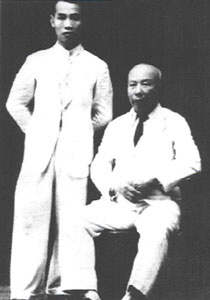
Wongfeihung
Wong Fei-hung (born Wong Sek-cheung with the courtesy name Tat-wun; 9 July 1847 – 17 April 1925) was a Chinese martial artist, physician, and folk hero. His recent fame was due to becoming the protagonist of numerous martial arts films and television series. Even though he was considered an expert in the Hung Ga style of Chinese martial arts, his real public fame was as a physician who practiced and taught acupuncture, Dit Da and other forms of traditional Chinese medicine in the now famous Po Chi Lam (寶芝林; 宝芝林; Bǎozhīlín; Bou2-zi1-lam4), a medical clinic in Canton (Guangzhou), Guangdong Province. A museum dedicated to him was built in his birthplace in Foshan, Guangdong.
Wong was a master of Hung Ga. He systematised the predominant style of Hung Ga and choreographed its version of the Tiger Crane Paired Form Fist, which incorporates his Ten Special Fist techniques. Wong is famous for using the Shadowless Kick. He named the techniques of his skills when he performed them.
Wong was adept at using weapons, such as the staff and southern tiger fork. One tale, possibly fictional, recounts how Wong defeated a group of 30 gangsters on the docks of Guangzhou with a staff.
Among Wong’s students, the more notable ones include Lam Sai-wing (林世榮; Lin Shirong), Leung Foon (梁寬; Liang Kuan), Dang Fong (Deng Fang), and Ling Wan-kai (凌雲階; Ling Yunjie).
Wong is sometimes incorrectly identified as one of the “Ten Tigers of Canton”. His father, Wong Kei-ying, was one of the ten but Wong himself was not. Wong is also sometimes referred to as the “Tiger after the Ten Tigers”.
According to a folklore, So Chan also taught Wong Fei-hung in drunken boxing.
Chan Hon Chung
Chan Hon Chung, Patron of the Orthodox Hung Gar
Chan Hon Chung was born in 1909 in Hing Ling County, (Guangdong Province, China). When he was 12 years old, he came to Hong Kong.
There he became a student of the famous Hung Gar master Lam Sai Wing and spent a lot of time in his school in Central District, Hong Kong. (Lam Sai Wing Gwok Seut Se Dai Yat Ji Bou) Lam Sai Wing was the most outstanding student of the legendary Wong Fei Hung.
Chan Hon Chung’s self-discipline and dedication to his Hung Gar/Hung Kuen training was immeasurable. He soon became known as the ‘Best Fighter’ of the Lam Sai Wings school, unbeatable in sparring matches.
Chan Hon Chung was travelling in Guangdong Province on business at the time of the ‘Japanese Aggression’. At the beginning of the military he taught about 100 volunteer swordsmen and therefore stayed there for some time. Afterwards he opened his own Kung Fu school in Hong Kong, the ‘Hon Chung Gymnasium’. There he taught Hung Kuen open-heartedly and according to traditional values transmitted to him by his teacher Lam Sai Wing. Master Chan was one of the first Kung Fu teachers in Hong Kong to accept non-Chinese as students. Many people in Hong Kong were amazed that he taught even the most advanced forms (e.g. Kun Lun Gim and Tid Sin Kuen) to non-Chinese. He did this for the sake of the development of Hung Gar style.
Mentor
Chan Hon Chung and his teacher Lam Sai Wing.

Master Chan was an important co-founder and long time president of the Hong Kong Chinese Martial Arts Association. This organisation brought over 90% of Hong Kong’s Kung Fu masters under one roof and represents all styles in the colony. The H.H.C.M.A.A. remains one of the most important Kung Fu associations in the world and is, so to speak, the political headquarters for Kung Fu in Hong Kong.
Training
Chan Hon Chung teaching

Chan Hon Chung was a devoted member of the Rotary Club and helped tirelessly in many charity projects. In gratitude for his services to Hong Kong, he was awarded a Medal of Honour by Queen Elizabeth 2 of England in 1970.
It is also worth mentioning that Master Chan taught Hung Gar Kung Fu to many people in the film industry (Hong Kong). He was an advisor for the first 10 Wong Fei Hung series (with the famous Kwan Tak Hing), in which he also acted himself. Worth mentioning is, for example, the episode in which he excellently executes the ‘Ng Long Ba Gwa Gwun’ partner stick form.
In Hong Kong, Master Chan was also known as the ‘Dit Dar’ doctor. The knowledge of ‘Dit Dar’ (kungfu chiropractic and herbal medicine) is an integral part of Hung Gar style. In recognition of his skill in ‘Dit Dar’, a hospital wing was even named after him in China. Chan Ka Wang (Edward), Master Chan’s son, and Hui Wing (Master Chan’s disciple) carry on the tradition of ‘Dit Dar’ today.
Chan Hon Chung died in Hong Kong in March 1991.